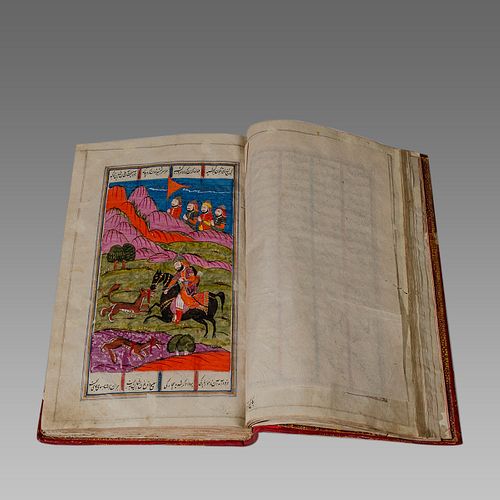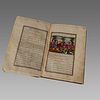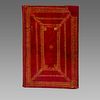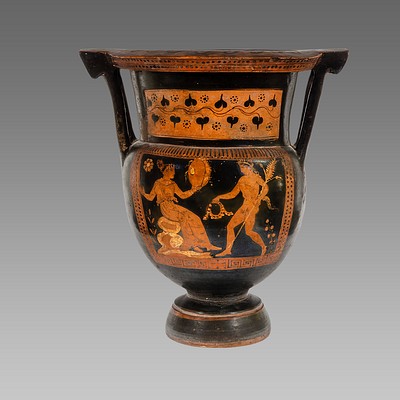Firdawsi of Tus, Abu'l-Qasim. Shahnameh. A significant and folio manuscript
Lot 415
Categories
Estimate:
$35,000 - $40,000
Absentee vs Live bid
Two ways to bid:
- Leave a max absentee bid and the platform will bid on your behalf up to your maximum bid during the live auction.
- Bid live during the auction and your bids will be submitted real-time to the auctioneer.
Bid Increments
| Price | Bid Increment |
|---|---|
| $0 | $10 |
| $100 | $25 |
| $500 | $50 |
| $1,000 | $100 |
| $5,000 | $250 |
| $10,000 | $500 |
| $20,000 | $1,000 |
| $50,000 | $2,000 |
| $100,000 | $2,500 |
| $200,000 | $3,000 |
About Auction
By Palmyra Heritage Gallery
Feb 28, 2021
Set Reminder
2021-02-28 11:00:00
2021-02-28 11:00:00
America/New_York
Bidsquare
Bidsquare : Antiquities, Islamic Art. Ancient Coins Sale
https://www.bidsquare.com/auctions/palmyra-heritage-gallery/antiquities-islamic-art-ancient-coins-sale-6430
Fine Collection of Classical Antiquities Greek Vases, Egyptian and Islamic Art & Ancient coins. from various estates. Palmyra Heritage Gallery info@palmyraheritagegallery.com
Fine Collection of Classical Antiquities Greek Vases, Egyptian and Islamic Art & Ancient coins. from various estates. Palmyra Heritage Gallery info@palmyraheritagegallery.com
- Lot Description
Firdawsi of Tus, Abu'l-Qasim. Shahnameh. A significant and folio size manuscript of 332 leaves (664 pages). It covers the second half of the Shahnameh, which is the most interesting and significant. There are two illuminated title pages one for Section Three, the other for Section Four. Plus 33 elaborate miniature, most of them almost full page. The miniatures are clearly of Indian origin. The manuscript was probably written and executed in Kashmir.Folio Size: 28 x 28 cm; written surface: 12.3 x 22.8 cm; It is written in four columns, in nasta`liq script in black ink, 21 lines to a page, with all headings in red ink on decorated gold strip. All pages are ruled in several lines of gold, red, and blue. All columns are separated by red and gold or blue and gold vertical lines. There are two seal impressions on the last page. The seal reads: Sayyid Muhammad Nuh 1293. The date 1293 of the Islamic calendar corresponds to 1876 AD. The manuscript was probably written in the late eighteenth century or early in nineteenth century. The manuscript is bound in nineteenth century morocco, new spine, with gilt scroll work in an arabesque design.The manuscript was sold in an auction. The auction slip describing the manuscript is pasted on the front flyleaf. The slip claims that it was written in ?? [I cannot read]. This was crossed and written over it in ink 17th century.The manuscript was bought by E. C. Simpson, whose bookplate was pasted on the inner side of the front cover. The bookplate is titled Sapere aude [Latin for: Dare to know There are some wormholes, mainly marginal, a few leaves with professional edge repair, otherwise an excellent copy Firdawsi, more commonly transliterated as Ferdowsi (or Firdausi), (940–1020) is a highly revered Persian poet. He was the author of the Shahnameh, the national epic of the Persian people and of the Iranian World. Ferdowsi, the son of a wealthy land owner, was born in 940 in a small village named Paj near Tus in Khorasan, North East of Iran. His great epic, the ShÄhnÄmeh ("The Great Book": in Persian, Shah means king, monarch or dynast, but when it is used as a prefix, it means "Big", "Great" or "Major".), to which he devoted more than 35 years, was originally composed for presentation to the Samanid princes of Khorasan, who were the chief instigators of the revival of Iranian cultural traditions after the Arab conquest of the seventh century. When he was just 23-years old, he found a “Shahnameh†written by Abu Mansur al-Mu`ammari; it was not, however, in poetic form. It consisted of older versions ordered by Abu-Mansur Ibn Abd ar-Razzaq. The discovery would be a fateful moment in the life of the poet. Ferdowsi started his composition of the Shahnameh in the Samanid era in 977 A.D. During Ferdowsi’s lifetime the Samanid dynasty was conquered by the Ghaznavid Empire. After 30 years of hard work, he finished the book and two or three years after that, Ferdowsi went to Ghazni, the Ghaznavid capital, to present it to the king. There are various stories in medieval texts describing the lack of interest shown by the new king, Sultan Mahmud of Ghazni, in Ferdowsi and his lifework. According to historians, Mahmud had promised Ferdowsi a dinar for every distich written in the Shahnameh (60,000 dinars), but later retracted and presented him with dirhams (20,000 dirhams), which were at that time much less valuable than dinars (every 100 dirhams worth 1 dinar). In other words, he presented him with 200 dinars instead of 60,000 dinars. Some think it was the jealousy of other poets working at the king’s court that led to this treachery; the incident encouraged Ferdowsi's enemies in the court. Ferdowsi rejected the money, and, by some accounts, he gave it to a poor man who sold wine. Wandering for a time in Sistan and Mazndaran, he eventually returned to Tus, heartbroken and enraged. He had left behind a poem for the King, stuck to the wall of the room he had worked in for all those years. It was a long and angry poem, more like a curse, and ended with the words: "Heaven's vengeance will not forget. Shrink tyrant from my words of fire, and tremble at a poet's ire."Ferdowsi is said to have died around 1020 in poverty at the age of 85, embittered by royal neglect, though fully confident of his work’s ultimate success and fame (clearly seen, especially in the last verses of his book). One tradition claims Mahmud re-sent the amount promised to Ferdowsi’s village, but when the messengers reached his house, he had died a few hours earlier. The gift was then given to his daughter, since his son had died before his father at the age of 37. However, his daughter refused to receive the sum, thus making Ferdowsi’s Shahnameh immortal. Later the king ordered the money be used for repairing an inn in the way from Merv to Tus, named “Robat Chaheh†so that it may remain in remembrance of the poet. This inn now lies in ruins, but still exists. Some say that Ferdowsi's daughter inherited her father's hard-earned money, and she built a new and strong bridge with a beautiful stone caravanserai nearby for travelers to rest and trade and tell stories. Ferdowsi was buried at the yard of his own home, where his mausoleum now lies. It was not until Reza Shah Pahlavi's rule, in 1925, that a mausoleum was built for the great poet. His masterpiece, the Shahnameh, is the most popular and influential national epic belonging to the Iranian people that at one time made up the greater Persian Empire, named in Prophet Zarathustra's Gatha as Airyanem Vaejah, in Shahnameh as Iran, and in Greek as Persian Empire. The Shahnameh (Book of Kings), or "The Great Book" consists of the translation of an even older Middle Persian work titled the Book of Lords. It has remained exceptionally popular among Persians for over a thousand years. It tells the history of old Persia before the Arab conquest of the region. This tale, all written in poetic form and in Dari Persian, starts 7,000 years ago, narrating the story of Persian kings, knights, system of laws, religion, victories and tragedies. The main source of Ferdowsi for historical and some of the mythological events was "Khodaynama", a book which was gathered and written during the Sassanid era. Another story tells us that Ferdowsi was commissioned by Sultan Mahmud of Ghazni to write a book about his ow valor and conquests. However, the poet, though dedicating the book to the King for an agreed fee of 30 horses loaded with gold coins, decided to tell the story of the Kings that had made the land of Persia into an Empire throughout the ages. This task was to take the poet some thirty years or more, during which he included the verse: Upon the presentation of the Shahnameh, Sultan Mahmud was furious for not being the subject of the book and finally betrayed the agreement by offering Ferdowsi thirty camels loaded with Silver; the offer was refused by the poet. Heartbroken and poor the poet returned to his hometown of Tus, the Sultan eventually realizing his error and the true value of the Shahnameh sent the agreed fee to the poet yet, upon the arrival of the camels the Ferdowsi's coffin was being carried out through the exit gate of Tus to his grave. "Knowledge is power". Ferdowsi is one of the undisputed giants of Persian literature. After Ferdowsi's Shahnameh a number of other works similar in nature surfaced over the centuries within the cultural sphere of the Persian language. Without exception, all such works were based in style and method on Ferdowsi's Shahnameh, but none of them could quite achieve the same degree of fame and popularity as Ferdowsi's masterpiece.Ferdowsi has a unique place in Persian history because of the strides he made in reviving and regenerating the Persian language and cultural traditions. His works are cited as a crucial component in the persistence of the Persian language, as those works allowed much of the tongue to remain codified and intact. In this respect, Ferdowsi surpasses Nizami, Omart Khayyam, Asadi Tusi, and other seminal Persian literary figures in his impact on Persian culture and language. Many modern Iranians see him as the father of the modern Persian language.
- Shipping Info
-
SHIPPING FEES are the responsibility of the buyer. We can handle most of the shipping of the items we are selling, or we can recommend a local UPS Store to Handle it. All buyers will receive an invoice detailing their purchases, sales tax (if applicable), buyer's premium, and shipping/insurance charges. Items will be shipped only upon receipt of payment in full and will be insured for their full value. For shipments outside of the USA, customs and duties may apply upon entry in to host country, and this fee, if any, is the buyer's responsibility. We will not falsify customs value on international shipments! If you have questions about this, please inquire before bidding.
-
- Payment & Auction Policies
-
Available payment options
-
- Buyer's Premium



 EUR
EUR CAD
CAD AUD
AUD GBP
GBP MXN
MXN HKD
HKD CNY
CNY MYR
MYR SEK
SEK SGD
SGD CHF
CHF THB
THB














